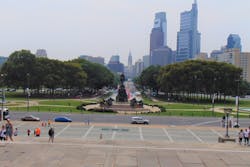City of Philadelphia seeks design team to reimagine Benjamin Franklin Parkway
The City of Philadelphia recently kicked off a search for an urban design team to reimagine the design and function of the city's iconic Benjamin Franklin Parkway.
The city is requesting proposals from renowned design teams to create a world-class public realm plan for pedestrian-centric, permanent changes that the city says will dramatically improve the appeal, use, safety, functionality, and beauty of the Parkway.
After an initial request for qualifications, a selected number of qualified design teams will be invited to take part in phase one of the design process: An Ideas Workshop. The public presentations are expected to take place in June 2021 and participating teams will receive an honorarium for their participation.
The ultimate design and engagement work will include an in-depth public engagement process, schematic design, a recommended project schedule, and cost estimates. The resulting plan for the future revitalization of the Benjamin Franklin Parkway will be based on innovative people-centric design ideas and creative approaches to transportation, economic development, and storm water management along with phased implementation, according to the city.
“Today’s Parkway is more welcoming to foot traffic than any time in recent memory,” Deputy Managing Director for Transportation Mike Carroll said in a statement. “The opportunity to provide improved pedestrian connections through Eakins Oval to the Art Museum steps is exciting, and an indication of how far we have come in laying the foundation for a public thoroughfare that is as livable as it is iconic, and as welcoming as it is grand.”
Since the launch of the city's More Park, Less Way plan in 2013, the city has implemented a series of the plan’s recommendations to improve pedestrian safety and activate public spaces along the Parkway. These include traffic calming measures, such as:
- Improved pavement markings along the Parkway to create more buffered areas that people should not drive, ride, or walk within.
- Added more directional indications like arrows and messaging painted directly onto the road surface.
- Added more conflict pavement markings indicating where one can expect cars and bikes crossing paths.
- Added soft rumbles, which are raised rumble strips that discourage speeding.
- Increased the number of pedestrian crosswalks indicating the best locations for pedestrians to navigate around and over the Oval and Circle.
- Installed flexible delineator posts at key locations which help keep users in their lanes and help to slow excessive speeding and erratic lane changes.
-----------
SOURCE: City of Philadelphia
